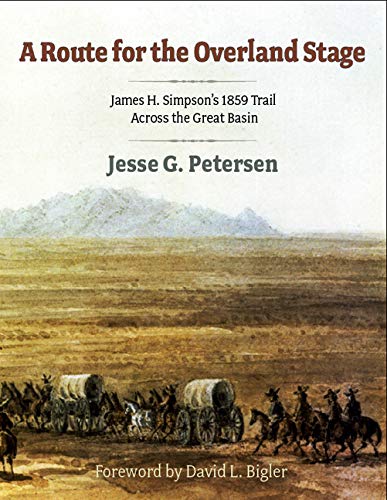Jesse G. Patterson, A Route for the Overland Stage: James H. Simpson’s 1859 Trail Across the Great Basin (2008)
 This is a wonderful, unpretentious, highly informative book. To quote from the introduction:
This is a wonderful, unpretentious, highly informative book. To quote from the introduction:
“During the summer of 1859, Captain James Simpson of the US Army’s Corps of Topographical Engineers led an expedition of exploration from Camp Floyd to Genoa. Camp Floyd was an army post in Cedar Valley, about forty miles southwest of Great Salt Lake City. Genoa was a small settlement located at the eastern foot of the Sierra Nevada mountains. The mission of the expedition was to fi nd a practical route for wagons through the central part of Utah and Nevada. If such a route could be found, it was believed that it would shorten the distance between Salt Lake City and California by as much as two hundred miles.”
In late 1859, Simpson’s route became the route followed by George Chorpenning’s Salt Lake City to Placerville mail route; in the early 1860s it became the Overland Stage route, and, with some variations, the Pony Express trail; the Lincoln Highway followed it in the early 20th century, as does US 50.
In the early 2000s, the author set out to follow as closely as possible Simpson’s 1859 expedition route, both west- and east-bound legs, and to map as accurately as possible the places where the expedition camped. The book breaks the account down as Simpson did, by daily reports, and adds reports from others on the expedition, then recounts the author’s various attempts to locate the route the route and campsite. In that sense, this book is similar to Irene Paden’s accounts in The Wake of the Prairie Schooners and Prairie Schooner Detours, which follow the emigrant trail with excerpts from emigrants’ diaries and accounts of her family’s attempts over the course of ten or so summer vacations to follow the trail.
This past summer I made a few trips out to central Nevada to scout portions of the Pony Express Bikepacking Route. I came across this book, which you can also download as a PDF for free, and it became a great resource in scouting the route. Not so much for finding the trail, per se, as for the context. The author gives the Shoshone and Ute names for mountain ranges and rivers along with stories about Simpson, the scout (John Reese), and other facts and information that make riding the trail more than just about riding a bike on a trail. He also reports his experiences trying to find the trail and campsite, which can be telling. For instance, getting stuck in a damp Fourmile Flat (east of Simpson Pass, near Sand Springs Station, and using a come-along to pull his 4×4 out. I rode out to that same spot, and while it was dry when I went, it was easy to see how one could get stuck.
I cannot say I’ve read this cover to cover. Instead, I’ve just read the portions that covered the sections of trail I was scouting. But I do intend to read through it before I ride the entire Pony Express Bikepacking Trail to get more background on the other sections of Nevada and Utah I haven’t scouted.